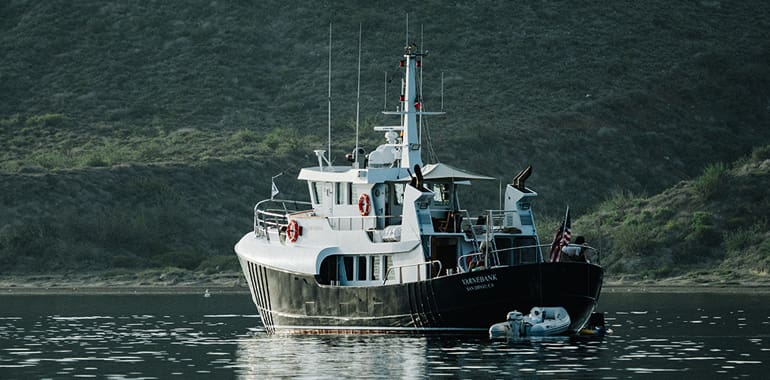[gtx_gallery]
Finding the perfect boat is a personal journey, one which can take you months or even years and many miles before the right one shows up. For me the search took me around the world, when I realized that what I wanted couldn’t be found in North America. A love of the solid seaworthiness and beefy good looks that comes with the North Sea Trawler design led me to the Netherlands where I found my boat.
After engaging a naval architect to design the perfect expedition yacht, I decided to find one ready to go. My search took me to the Low Countries where MS Varnebank (the Dutch call them motor ships) was being offered for sale. Originally a North Sea fishing trawler, her previous owner, a Dutch marine surveyor with a talent for rebuilding older boats, had stripped her down to practically nothing and rebuilt her from the keel up. The only original parts left on the ship were the manual propeller shaft grease pump and the engine room ladder. All of the metalwork in the hull and superstructure, including a totally redesigned aluminum pilothouse, was fabricated locally. The beautifully hand-done interior of cherry and mahogany was completed by one craftsman over a period of a year. Much of the machinery was taken from other workboats and rebuilt before installation. Her Dutch owner named her after the Varne Bank shoal in the Strait of Dover, known for its rough seas and shallow depth.
On paper Varnebank seemed to be everything I was looking for, so my broker, Christy Crawford, flew over to have a look at the boat. In 2010 I flew over and took ownership, getting Varnebank U.S.-documented while I was there. Accompanied by my son, I took Varnebank to Southampton, UK, where she was loaded on a freighter destined for Golfito, Costa Rica, with a stopover in West Palm Beach, Florida. After transiting the Panama Canal, the drop off point was happily changed to Manzanillo on the west coast of Mexico. Varnebank remained in Mexico for a year until 2011, when Christy and I moved her north to her new home in San Diego.
Offshore and technical experience
Christy and I share a common background in ocean racing, having met while we were both working on the Americas Cup defense in 1983. I am a long-time aircraft mechanic and pilot, giving me a background that has been useful in running and maintaining Varnebank. Christy had spent years as a sought-after and highly successful navigator, using both celestial navigation and modern methods. She is also an experienced weather prognosticator. She is an expert co-captain and often takes the helm while maneuvering.
Varnebank is made to withstand heavy weather in the North Sea, and she looks and feels like it. Watertight exterior doors provide ample protection in rough seas and there is a searchlight taken off a Royal Navy Destroyer. The tender is launched from the aft deck by a powerful Ferrari knuckle crane. On the main deck, the galley is large, with doors for easy access outside and open to the saloon. Forward, there is an office area, and through another watertight door, is the anchor locker, where the huge hydraulic windlass lives.
Varnebank, which displaces 180 tons fully laden, has a single screw, powered by a 29-liter Mitsubishi S6 Marine engine de-rated to 580 hp for continuous duty. The normal cruising rpm of 1,000 is further reduced by a large Reintjes marine gear with a 3.94:1 ratio making for a quiet and smooth 250 prop rpm. She carries 6,300 gallons of diesel in multiple tanks. For electrical power there is a 20kW genset, providing 230V single phase and 400V three phase. 50-hz AC power. Engine-driven generators and Victron battery chargers provide ample 24V DC power. In order to provide European voltage and frequency from North American shore power, there is a 35-kW A/SEA shore power converter in the engine room. At anchor and underway, a 5-kW inverter supplies 230V AC for most house loads. As Christy and I are both amateur(ham) radio operators, Varnebank is equipped with a powerful SSB radio open to marine and amateur bands.
Varnebank has four independent hydraulic systems: one for normal power steering and hydraulic fin stabilizers, one for backup power steering, another to operate the aft deck crane, and a fourth to power the anchor windlass and bow thruster. The windlass and thruster systems are powered by an 85-hp Perkins diesel located in the engine room providing sufficient power to manage the 350-pound anchors and 500 feet of heavy chain.
As for accommodations, there are five double cabins on a lower deck, two forward for crew, two amidship for guests, each with its own en suite head and a desk. The master stateroom aft has its own head and shower. These are provided with hot and cold water, with a 1,200-gallon water tank and a 720-gallon/day water maker. Heating is by a diesel-fired boiler circulating hot water through radiators, including towel warmers in all the heads.
While some of our cruising has been in the picturesque Channel Islands off the coast of California, most of our time away has been in Mexico, particularly in the Sea of Cortez. We’re planning to return in the fall of 2021.
Ken and Christy Donnelly live in the San Diego area and can be reached at varnebank@gmail.com.

